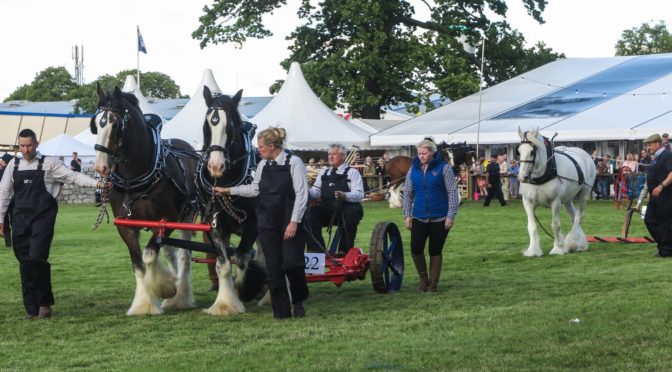The Highland Show provides a glimpse into the latest agricultural implements and machines in a. year. Scottish makers were keen to have their latest developments and innovations on show. They also wanted to ensure that customers were aware of their bread-and-butter manufactures as well.
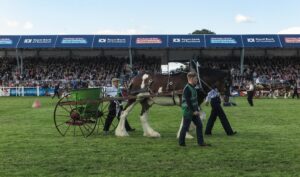
Newspaper accounts of the implement department of the Highland Show usually include detailed descriptions of the various stands held by the implement makers. They also tended to focus on what was new, what was to be noted and the general trends to be observed in the implement department. Such accounts can help us chart periods of great innovation nd developments and periods of stagnation. One period of difficulty was the extensive depression that continued from the late 1870s to the first decade of the twentieth century. It was characterised by huge imports of foreign produce, especially grain, which suppressed the demand for local Scottish and UK produce. This led to a reduction in the acreage under crops, the need for implements and machines to work the land. Also, there was a reduced demand for workers. However, costs were also increasing, with some demand for innovation in machinery. However, farmers ere careful of their purse, having less to invest.

The Highland Show in 1904, coming towards the end of an extensive period of depression makes an interesting read. The Scotland writes of the the Show:
While there is much to interest and instruct, and a good deal that deserves the attention of agriculturists, there are no absolute novelties in the implement section, manufacturers in recent years being more employed in effecting minor improvements in existing implements than in investing new ones. But small and simple as these improvements may appear, they are in many cases of considerable importance, being directed, for the most part, to simplifying the gear, lightening the draft, and securing increased durability. The Society, as has already been stated, have arranged for the trial of agricultural motors, and two competitors have entered machines-Mr John Scott, Edinburgh, and the Ivel Agricultural Motors (Limited), London. It was at first intended that there should be a trial in a hayfield during the show week, but this was afterwards found to be impracticable, and it was decided to hold the trial during the harvest, and that the machines should be tried in cutting grain, in ploughing, and in general tillage. The importance of the implement industry in the economy of the farm is well illustrated by largeness of the area set apart for the display of exhibits of machinery and appliances for expediting the work of the agriculturist, the space allotted to the stands being 6000 feet. In an important centre like Perth it was unlikely that the show of implements would not be of a representative character, and a walk round the stands to-day demonstrated that in every way the exhibition is worthy of the Society, and of the occasion which brings so many different types and specimens of implements of husbandry together. The exhibits number 1972, being 138 more than at Dumfries last year, and slightly in excess of those at Perth in 1896. First in the list of exhibitors stands Mr William J. Elsey, Murrayfield, Edinburgh, who has on view a number of corn and seed dressing machines, in one of which the blowing is quite independent of and apart from the riddling. They also show sets of fanners, fitted with Elsey’s patent blowing apparatus, and grass and clover seed machines, the under screens of which have a peculiar
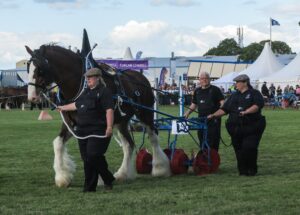
jumping motion. Messrs William Reid & Leys, Aberdeen, are represented by “Highland” and “Don” ploughs, spring tooth cultivators, and horse hoes, which show many improvements. Messrs Thomas Sheriff & Co., West Barns, Dunbar, show several of their well-known corn drills, broadcast sowing machines, and manure distributors, which have been improved in several particulars, and are now of great utility to the farmer. A good display of implements is made by Mr A. Pollock, Mauchline, who work has long been famed for excellence and durability. He has on show a variety of hay collectors and bogies, a potato digger which has proved itself effective for the work for which it was designed, carts of sound construction, reapers and mowers, hay and straw presses, cheese presses, and curd mills, all of marked utility. A large and comprehensive stand is that of Messrs H. W. Mathers & Sons, Errol. They show an assortment of mowers, binders, ploughs, and cultivators, all of which are of tried serviceability. From Messrs Macdonald Brothers, Portsoy, have come a one-horse self-acting back-delivery reaper, an “Ideal” manure distributor, a turnip lifter, wheel barrows, and a roadside paring machine. Messrs A. Newlands & Son, Linlithgow, have a large collection, prominent among which is their spring tooth cultivator. This machine is made in three sections, and each section is operated upon by one spring which gives the necessary vibration. Potato diggers, horse rakes, ploughs, manure distributor, drill grubbers, and harrows are included among their other exhibits. Mr George Barker, Perth, shows a varied selection of machines and implements, embracing the “Sutherland” patent thistle cutter, which has been greatly improved. Messrs Wm Elder & Sons, Berwick, have a large display, comprising a great variety of implements, including ploughs, cultivators, sowing machines, harvesting machines, hay bogies, turnip toppers, tailers and slicers and a patent thistly cutting machine. Messrs J D Allan & Sons, Murthly, in a large variety of appliances, show their farmyard manure spreader. This machine when working is fitted with two light wheels. One goes on the top of the drill and the other in the furrow. It can be regulated to any breadth, and can put down manure from ten to twenty tons per acre. It is an ingenious and useful invention. Prominent among the splendid collection of Thomas Hunter & Sons, Maybole, are the far-famed Hunter hoes, which are fitted up to serve the threefold purpose of a cultivator, a scarifier,
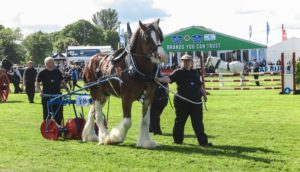
and a moulding-up plough. Also on view are the equally well-known Hunter ploughs and topping and tailing machines, as well as a variety of rollers, turnip drills, and double drill scarifiers. A couple of useful potato-dressing machines for filling baskets and bags are exhibited by Mr David Wilson, Riccarton, Linlithgow, who also shows boxes for sprouting seed potatoes. Messrs Rollo & Creighton exhibit samples of their manufactures in wheels, spokes, and hubs, which are made from the best home timber and are of excellent workmanship. They have also on view a new design in ornamental oak gates suitable for policies and public parks. Messrs J & R Wallace,
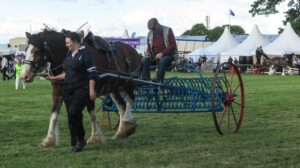
Castle Douglas, exhibit a new machine in the form of a sheep dipper. The new machine is a perforated cage, into which the sheep enters and is lowered feet downwards in the dip. The machine is so arranged that two men only are required to work it. The firm have also on exhibition their patent manure distributors, which have acquired an excellent reputation. “Express” cultivators, “Excelsior” hoes, improved horse rakes and harrows are shown in great profusion by Messrs John Scoular & Co., Stirling. Messrs Kemp & Nicholson have at their stand a very large assortment of implements which should attract attention by reason of their excellence of construction and efficiency in working. Messrs John Wallace & Sons, Glasgow, have a fine display of the well-known implements with which the name of the firm has long been associated Among a variety of appliances they show the world-famed “Oliver” chilled ploughs, their champion potato digger, and thistle mowers and reapers. Messrs J. Bisset & Sons (Limited), Blairgowrie, shows specimens of their famous “Bisset” binders, mowers, and reapers; the “Speedwell” back delivery reaper, “Champion” Empire potato diggers, and a potato planter. Mr Matthew Dunlop, Glasgow, shows “Royal” reapers and mowers, “Lion” horse rakes, and a number of other machines made by Bamford & Sons. Messrs Gray & harrower, Alloa, display “Plano” binder, mower and reaper; hay rakes, and sickle grinders. Messrs Alexander Jack & Sons (Limited), Maybole, exhibit attractive specimens of their specialities, which, on account of their reliability, are now more freely requisitioned than ever in all parts of the world. As makers of harvesting machinery, they exhibit
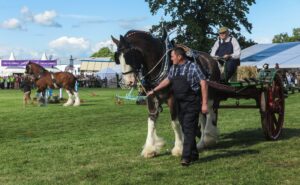
an effective hay rake, and samples of their well known “Empire” combined reapers and mowers, a light Anglo American rake, the “Dandy” samples of English and American tedders, and the McCormick binder, fitted with ball and roller bearings. Manure distributors are a leading speciality with Messrs Jack. Their chain delivery distributor, of which an 8 feet size is staged, is useful in dealing with basic slag, ground lime, and similar dry manures. Their newest product in this line is the “Empire” combination force feed and revolving disc delivery artificial manure distributor with new patented improvements for 1904, which is exhibited for the first time at the Highland Show. The firm’s reputation in potato diggers is well known. The Caledonian, which gained the first prize of £20 at the latest R.A.S.E. field trials in 1896, has been much enhanced in value by the addition of ball and roller bearings and a new system of draught by chain from underneath the centre of the machine. Messrs Jack’s cart and van making department is represented by a couple of nicely finished farm carts, sample spring vans and chapel carts and a smart, substantially-built lorry. The “Dux” ploughs, for which Messrs Jack are sole agents, and which are manufactured for them specially to suit the requirements of North British agriculturists, are shown in three patterns, both single and double furrow. A. & J. Main & Co. Limited, Edinburgh, occupy one of the largest and best arranged stands on the ground. Their specialities include several samples of the new patent “Deering” ideal binder. There is also on exhibition the famous “Deering’ ideal two horse mowers, which contain several improvements, including that of a higher
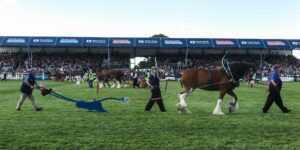
speed. Amongst the collection there is also on exhibition for the first time the “Deering” ideal two horse mower, which has been fitted with a special bar, making the machine a combined grass cutter, and also converting it into an efficient thistle and bracket cutter. Attention may also be called to the “Deering” all steel hay rake, the leading feature of which is the use of high grade steel, resulting in great strength, with extreme lightness in draught. The firm also display the new Empire cultivator of their own manufacture (which has just been awarded the special silver medal of merit, from the East Lothian United Agricultural Society), which is specially designed for the deep cultivation of heavy and clay lands. This implement can also be used as a three drill grubber, and as a three drill ridging plough, and will perform from eleven to thirteen acres per day with one pair or horses. A new machine for distributing farm yard manure is also shown, which will spread any desired quantity of manure uniformly and without leaving any bare spots. A selection of Empire collapsible grinders are shown, which are equipped with ball bearings, making them very easy to work. Messrs John Doe Limited, Errol and Perth, have on exhibition “Plano” lever binders, and a number of well known harvesters and binders, reapers and mowers, horse rakes, and cultivators. Mr J. Campbell jun, Coupar Angus, has sent forward how potato planter and potato digger, which should be found useful to potato growing farmers. Messrs Milne and Macdfonald, Lockerbie, show “Adriance” binders, mowers, and makes, and a “Dux” plough. A good display is made by Messrs Georrge Sellar & Son, Huntly, their ploughs, grubbers, harrow, drill scufflers, broadcast and turnip sowers, and horse rakes commanding attention for their superiority of workmanship, Messrs David Steele & Son, Folwlis Easter, Dundee, have on view a large assortment of machines, including hoe grain drill, turnip sowers, hay collectors, and McCormick harvesters and binders.

One of the most extensive stands in the showyard is that of the well-known form of Messrs Thomas Gibson & Son, Bainfield Iron Works, Edinburgh, and it occupies a conspicuous place near the official pavilions. It has a run of 80 feet, and contains about 140 articles, the enumeration of which fills over six pages of the catalogue. Their ornamental ironwork is always an outstanding part of their display, and it is seen here in many elegant forms of entrance gates. There are also numerous specimens of wrought-iron and wirework in artistic designs, and adapted to a variety of purposes. More immediately connected with agriculture are their corn rick stands, field gates, bar fences, and sheep fodder racks, which have now been familiar on the market for a considerable time; while their carriage gates, garden rollers, ornamental archways and other garden articles are not only ornate in appearance, but of beautiful workmanship, and of real practical utility. Among dairy appliances, Mr john Grey, Stranraer, has a near display of cheese vats of different sizes and other appliances essential to a well-equipped dairy. A feature of the exhibit of the Dairy Supply Company, Grassmarket, Edinburgh, is their cream separators, their turbine separators capable of dealing with from 65 to 150 gallons per hour, and their steam turbine pasteurizers, together with a collection of useful dairy utensils. An extensive assortment of churns, butter workers, and laundry appliances is to be found on the stand of Messrs Thomas Bradford & Co., Salford. The other exhibitors include Messrs William Sinton & Sons, Waverley Cheese Works, Jedburgh.
Accounts such as this are helpful in shedding light on the state of Scottish agricultural implement making at a difficult time.
